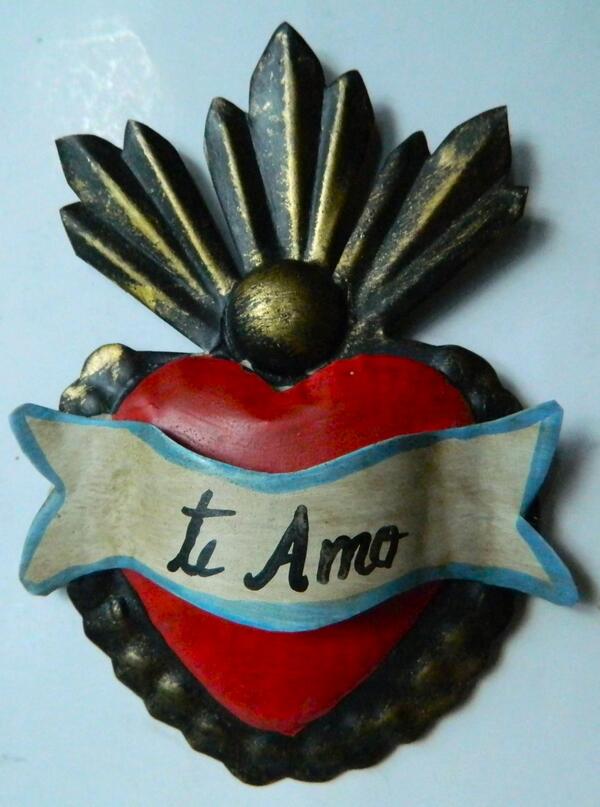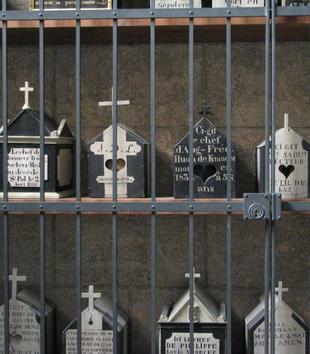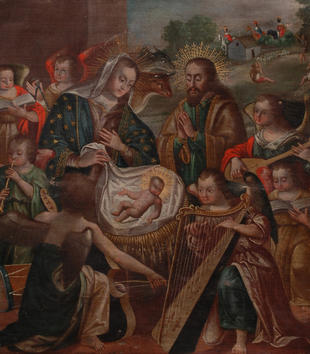This object was purchased in an upscale novelty shop catering to tourists in downtown Boulder, Colorado, in 2010 for $11.95. Although at first blush it appears to be a Sacred Heart of Jesus, on second look the banner, which reads "te amo," Spanish for "I love you," indicates that the heart may not belong to Jesus. As first described by Sister Margaret-Mary Alacoque (1647-90), the French Visitationist nun to whom Jesus appeared in a number of visions beginning in 1676, the Catholic devotional emblem of a flaming, bleeding heart bears a wreath of thorns. In the object at hand the blue and white banner appears in place of the thorns. Yet the three clusters of effulgent rays rising from the heart, painted gold, recall the flames atop the Sacred Heart that Alacoque envisioned. And the embossed pattern surrounding the red Valentine’s heart may correspond to the aureola surrounding the heart of Jesus in the traditional iconography of the Sacred Heart. The earliest diagram endorsed by Alacoque herself displayed such a Valentine-shaped heart, though the iconography that developed in the eighteenth century shifted to the portrayal of the heart as human organ, which has tended to prevail ever since.
The similarities are striking, and they are compounded by the use of pressed, embossed, gilt, and inexpensive metal. This is the medium of traditional ex-votos in Latino Catholicism—paintings on tin that fulfill a pledge and convey thanks to Our Lady for her favors. Pressed or cast metal was also the medium for small effigies of hands, legs, feet, or other body parts that pilgrims left at shrines or near altars in public acknowledgement of their healing. These material kinships may be deliberate when we consider that the object is a commodity designed to appeal as "genuine" or "authentic" kitsch, that is, something that looks like it's the real thing, but isn’t. The motif of the Sacred Heart is appropriated to produce a commercial knick-knack suitable as a gift for one’s partner. But at $11.95, the object is more than a cheap trifle. Its hand-painted, metal construction makes it something more, a gift that might occupy the chic category of "cool stuff." It is intended for display by hanging on the wall. A metal loop is fixed to the backside.
Specifying the object’s status in aesthetic and economic categories of taste-value is an important thing to do because that bears directly on what the object is. Its materiality remains unclear until we have a place to put it, that is, a way to see it, a cultural milieu in which to locate the object. But the ambivalence of the object, its invocation of religious artifact and personal gift-commodity made into an object of display capture something that is intriguing in its own right: the easy slippage of sacred mementos from the ritual context of pilgrimage and penance to commodity and souvenir. Trade is no stranger to religion, and pilgrimage has rarely excluded commerce as one way to acquire goods for the purposes of devotional practice and sacred memory.
If the Sacred Heart has become grist for the bourgeois tourist market, Jesus won’t be surprised. Alacoque stated in her Autobiography that he pursued her as a suitor and won her heart.1 Amorous affection was part of their relationship and the Valentine’s heart was an emblem of romantic love at least as early as the late Middle Ages, when it appears as "amor" in chivalric accounts in illuminated manuscripts.2 But this Heart was special. When Jesus presented the "burning furnace" of love to his cloistered paramour, he told her it was the heart with which he loved people so much, but "in return I receive from the greater number nothing but ingratitude."3 Yet adoration of the Heart, according to Alacoque, would render great benefits. Jesus declared to her that observing Mass in honor of the Heart would pay reparations for offenses against it. Devotion to His heart participated in a sacred economy that turned the reviled love of Jesus into a redemptive power. It remains for the study of our object’s reception to determine if it, too, heals the wounded heart of the beloved.



